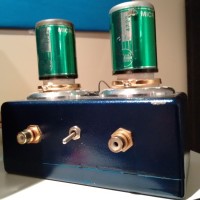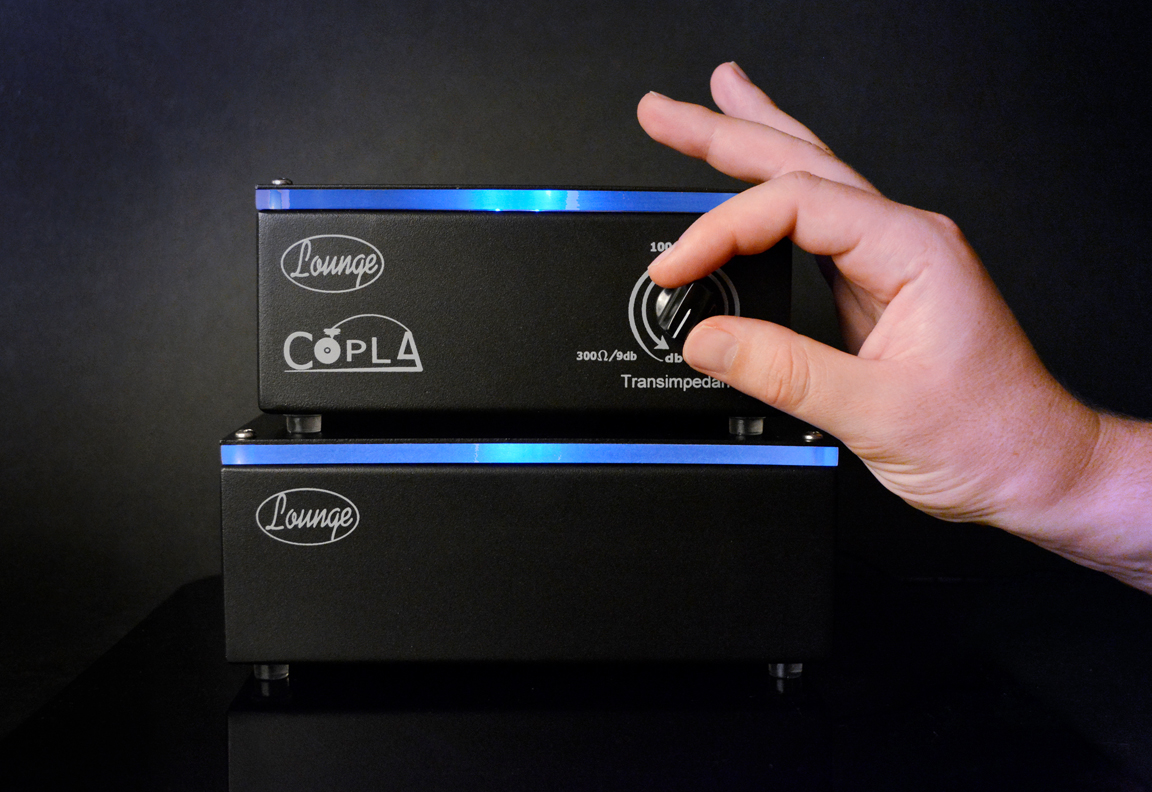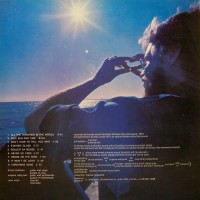Review by Noam Bronstein
These days, a product like the Copla on review here, is about as rare as the type of company that makes it: S.California’s Lounge Audio. See, the days of active head amps are by and large gone, and sadly, so are the days when an electronics whiz like Robert Morin comes along, developing and marketing quietly unassuming, super high-value offerings to the audiophile market – via his Lounge Audio enterprise.
Lounge’s LCR MkIII phono stage, which I reviewed here last year, is such a product. I couldn’t give it high enough praise, especially considering the $300 direct price. This time, we’re looking at the LCR’s new companion, or sister product. The Copla is an active step-up amplifier that retails direct for $270.
A bit of review. The LCR is a low-gain phono preamp, suitable for Moving Magnet (iron, permalloy) phono cartridges, as well as high-output Moving Coil types – often referred to as HOMC’s. But let’s say your LCR MkIII has brought you so much analog pleasure (a very plausible scenario!), that you feel the urge to upgrade your cartridge to a low-output Moving Coil (LOMC)? Maybe something like the venerable Denon DL-103, which only puts out 0.3mV – that’s about 1/15th of the voltage that the typical “MM preamp” needs to see.
This is where “step-up” devices come in. Transformers are the most common solution: they’re passive, they can be built with the correct ratio of “turns” for 10x, 15x etc voltage gain, and frankly, they tend to sound noticeably better than preamps which try to deliver 65-75dB of gain from a tiny MC phono signal. Downsides? Only a couple. Step-up transformers can hum in some environments. And they can be expensive to build: they’re essentially hand-wound, and good materials are costly. The market is also fairly small, so amortizing those costs is a challenge. All this to say that, while there may be one or two, there aren’t many outstanding solutions in the $300 price range*.
Well, Robert Morin aims for outstanding, and he aims for that particular price point. Does he succeed with the Copla? Having used a number of good, modestly-priced SUT’s over the years, including Lundahl, Sowter, Cinemag, and Altec, I was eager to find out.
The Copla is a ‘substantial half-size’ unit – not imposing by any means, but not tiny or diminutive either. It uses the same 18VDC power transformer as the LCR – this is another “global product”, so the supplied adaptor voltage is confirmed for your part of the world when you place the order. By the way, neither Lounge unit draws much current, so experimenting with battery power is certainly another avenue that could be worth exploring.
Connecting and using the Copla is a breeze. Sit it on top of the Lounge LCR (or your favorite preamp), hook it up with standard single-ended cables, and away you go. Once again, there’s no power button: it’s meant to be left on all the time. I’d suggest starting with the impedance/gain setting in the middle of its’ sweep. The range of adjustment available is pretty broad, and very clearly audible, but it’s not huge or dramatic. Like every great audio component, a lot of attention is paid to the power supply – in fact, that’s the Copla’s design m.o. The idea is simple (and brilliant): the power is fed to a bank of chunky light-emitting diodes (ten of them), and you can vary this with the adjustment knob. The diodes, in turn, supply precisely regulated voltage to the pair of transistors that handle the entire audio signal amplification. By increasing the impedance, you reduce the gain, theoretically this should provide a cleaner audio path/signal. Conversely, you can reduce the impedance, which gives you more apparent gain – as well as lower noise. Where your sweet spot lands is going to depend on your cartridge, and your phono preamp. In fact, it may also vary somewhat based on the kind of LP you’re listening to, as Robert explains. For those keen enough to spend 10 minutes, Mr. Morin elaborates on the Copla in the Youtube video below. Have a look.
https://www.youtube.com/watch?v=IBnxwatJu_w&feature=youtu.be
So by now, you’re starting to itch. “Forget the technical details, how does this thing sound???”
The Copla sounded superb in my setup. It had an effortless quality that I really enjoyed. Like a very good SUT, it made a great partnering solution for low(ish) impedance, low(ish) output MC’s – in my case, my own Charsima MC-1, as well as the Charisma 103 that I was reviewing during the same period of time (review pending). I ran the Copla into the Lounge LCR MkIII, and also into the phono input of my Elekit TU-8500 tube preamp (the Ellie uses an opamp phono section and a tube line stage). I had absolutely no issues with compatibility, noise, or any kind of impedance mismatching.
My current reference SUT is the vintage Altec 4722. These usually sell for about $500 a pair, at the moment. They may look old and cheesy, but the sonic ‘transformation’ (sorry) that they effect on LOMC’s is nothing short of glorious. Did the Copla equal the mighty Altec? The answer is a bit complicated, and reminds me of Jon Eben’s writeup of the Bob’s Devices (Cinemag) SUT a couple of months ago. The short answer is that the Copla is in the same league as these transformers, in my experience. They all share the same ability to communicate music on a direct and emotional level. There were differences in the presentation, but those differences were subtle.
I’ve always been mesmerized by ‘All The Diamonds In The World’, the opening track from Bruce Cockburn’s Salt, Sun and Time (1974). On this track I found the Copla sounded airier, maybe a little prettier – while the Altec SUT sounded more fleshed out and organic. Copla more flowery, Altec more meaty. Pick a flavor. Actually, pick a shade of the same flavor; they’re both strawberry. This impression carried with other music that I compared. They were different, yet the differences weren’t very dramatic. Both were super enjoyable, and just the kind of listening experience that compels you not to listen for nit-picking shades of grey. So don’t.
With a gun to my head, I’d say the Copla kept rhythm and timing a little better, while the Altec SUT had a little more body, and was maybe a touch slower. Given the small magnitude of these shades, I could happily live with either sound, and never miss the other. They were that close.
I didn’t end up purchasing the Copla, but it was a very close call. I already had the LCR MkIII, along with other preamps and the Altec SUT. In the end, I decided that sticking with my Altec made sense (for me) – but, if I were in the market for a step-up device in this price range, the Copla would be a no-brainer. It’s less costly and basically performs at the same level.
Los Angeles has long been a hub of great vinyl, and the recorded arts in general. One of my Altec 4722’s is from the Anaheim factory, the other indicates it was made in L.A. (coincidentally, Jon Eben has ‘mismatched’ units just like mine). L.A. Peerless trafo’s are more sought after than Anaheim, for reasons known only to collectors – I can’t hear a difference between them. Cinemag transformers are made in the nearby suburb of Northridge. And our friends at Lounge Audio make their products in Sylmar, another north L.A. suburb near the edge of the Angeles National Forest. Yes – these are made here in the western world, they don’t come from a wave soldering line in some nameless factory in the Far East.
 And that means something. Since around 2013-14, many companies have been jumping on the bandwagon, looking to cash in on the so-called vinyl revival. It’s a cash grab that, at the end of the day, is probably harming the recording industry more than helping it. More than ever, I think we should try to support the folks that have been toiling at this endeavour for years – simply because they love it. The ones that never gave up on analog sound. The people that continue pushing the limits of what can be achieved in the vinyl arts. Lounge Audio is that kind of outfit, and I highly recommend their Copla and LCR units. It’s a pleasure to award them our Gold Star Award, for outstanding quality, value and performance.
And that means something. Since around 2013-14, many companies have been jumping on the bandwagon, looking to cash in on the so-called vinyl revival. It’s a cash grab that, at the end of the day, is probably harming the recording industry more than helping it. More than ever, I think we should try to support the folks that have been toiling at this endeavour for years – simply because they love it. The ones that never gave up on analog sound. The people that continue pushing the limits of what can be achieved in the vinyl arts. Lounge Audio is that kind of outfit, and I highly recommend their Copla and LCR units. It’s a pleasure to award them our Gold Star Award, for outstanding quality, value and performance.
My thanks to Robert and Daniela again for providing the review sample.
Lounge Audio Copla step-up amplifier, $270 USD





